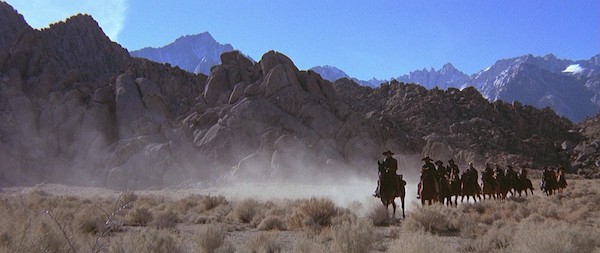Silver Screen Standards: Heaven Can Wait (1943)
While you might expect a movie about the balance of a man’s life being judged at the gates of Hell to be heavy existential stuff, Ernst Lubitsch’s Heaven Can Wait (1943) serves it up as a sparkling romantic comedy in the director’s quintessential style. Dapper Don Ameche makes the protagonist appealing in spite of his peccadilloes, and even the Devil himself seems charmed by the new arrival, but that’s just where the fun begins. There’s so much to love about this picture: Ameche’s performance, the gorgeous Technicolor cinematography, the delightful comedy scenes, and especially the extensive cast of outstanding supporting players. So many of my personal favorites have great roles, from Marjorie Main and Spring Byington to Charles Coburn, Eugene Pallette, and Laird Cregar, but Ameche and the beautiful Gene Tierney are perfectly cast as the leading lovers experiencing the many joys and sorrows of a life together.

Ameche stars as the newly deceased Henry Van Cleve, who presents himself to the Devil (Laird Cregar) for admission to Hell because he assumes that Heaven won’t take him. Henry then recounts his life, which he admits has been dominated by his relationships with women, starting with his doting mother (Spring Byington) and grandmother (Clara Blandick). Henry’s account of himself, told through a series of long flashbacks, primarily focuses on his marriage to Martha (Gene Tierney) and the years they spent together, although Henry feels that his self-indulgent behavior has not merited a reunion with his wife in Heaven.

Don Ameche is very much in his element as Henry, a feckless but amiable fellow whose deep love for Martha can’t make him behave as well as she deserves. Even in the later scenes, when he appears in increasing layers of old-age makeup, Ameche maintains his immense charm, though he transforms over the years from youthful rogue to geriatric playboy. His failures as a husband are mostly understated and unspecified, the better, perhaps, to retain our sympathy. In spite of his impulsive, careless nature, Henry certainly looks more appealing in contrast to his priggish cousin Albert (played in his adult form by Allyn Joslyn), to whom Martha is originally engaged. Albert has many fine qualities, which he enumerates to Martha, but he’s terribly dull and takes himself far too seriously to be any good as a lover. Gene Tierney has less to do than Ameche – she’s the object of his affection, not the subject of the story – but she is so breathlessly lovely and good that we understand why Henry resolves to marry her the moment they meet.

With a story that spans every decade of Henry’s life, the picture offers ample opportunity for supporting actors to make memorable appearances, and Heaven Can Wait ends up being a parade of fun scenes with familiar favorites, many of them uncredited. Florence Bates drops in – literally – as a fellow arrival in Hell. Child stars Scotty Beckett and Dickie Moore take turns playing Henry as a child, with Moore having an especially amusing sequence with Signe Hasso as the Van Cleves’ attractive French maid. In addition to Spring Byington and Clara Blandick, the Van Cleve family members are played by Louis Calhern, Tod Andrews (credited as Michael Ames), and the great Charles Coburn, who endures into ripe old age as Henry’s delightfully mischievous grandfather. Coburn is quite the scene stealer, but nothing beats Eugene Pallette and Marjorie Main as Mr. and Mrs. Strabel, Martha’s cantankerous Kansan parents. Watching the two of them fight over the funny pages, much to the amusement of their tactful butler, Jasper (Clarence Muse), is absolute comedy bliss. You could even call it classic movie Heaven.

Heaven Can Wait earned three Academy Award nominations, with nods for Best Picture, Best Director, and Best Color Cinematography, but it went home empty-handed. For more of Ernst Lubitsch’s signature comedy style, see Design for Living (1933), Ninotchka (1939), and To Be or Not to Be (1942). Don Ameche didn’t win an Oscar until very late in his life, when he really was an old man in Cocoon (1986), but you can catch him in his prime in Midnight (1939), The Story of Alexander Graham Bell (1939), and That Night in Rio (1941). You can see Gene Tierney, Laird Cregar, Spring Byington, and Clara Blandick in Rings on Her Fingers (1942), but Tierney is best remembered today for films like Laura (1944), Leave Her to Heaven (1945), and The Ghost and Mrs. Muir (1947). The 1978 movie titled Heaven Can Wait has nothing to do with the 1943 one, but it’s actually a remake of the 1941 supernatural comedy, Here Comes Mr. Jordan, which stars Robert Montgomery as a dead man sent back to Earth in a different body by guardian angel Claude Rains. Both are excellent movies that make fun double features with each other or the original Heaven Can Wait.
…
— Jennifer Garlen for Classic Movie Hub
Jennifer Garlen pens our monthly Silver Screen Standards column. You can read all of Jennifer’s Silver Screen Standards articles here.
Jennifer is a former college professor with a PhD in English Literature and a lifelong obsession with film. She writes about classic movies at her blog, Virtual Virago, and presents classic film programs for lifetime learning groups and retirement communities. She’s the author of Beyond Casablanca: 100 Classic Movies Worth Watching and its sequel, Beyond Casablanca II: 101 Classic Movies Worth Watching, and she is also the co-editor of two books about the works of Jim Henson.














































































































